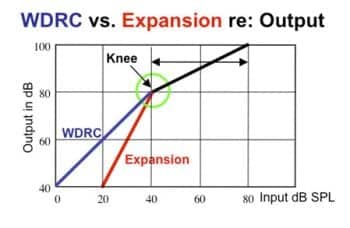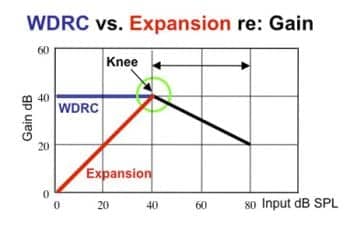This article is adapted from the July 17, 2011 blog post in the “Wayne’s World” section of The Blogs accessed at www.hearinghealthmatters.org.
— David H. Kirkwood, HearingHealthMatters.org

Three topics that are confusing to many who fit hearing aids are the distinctions between the TK Control, WDRC, and Expansion. Understanding differences between these concepts, and how they are used in amplification, is critical in the hearing aid selection and fitting process.
Basic Definitions
Basic definitions to help in understanding these differences:
- Linear Amplification: 1:1 input/output ratio; 45° angle on the target gain audiogram.
- Compression: Less than 1:1 amplification. Less than 45° angle on the target gain audiogram.
- Expansion: The opposite of compression; greater than 1:1 amplification, or greater than a 45° angle on the target gain audiogram. Expansion is one way to control potential circuit noise or feedback in quiet environments.
- Wide Dynamic Range Compression (WDRC): Input compression having a low kneepoint.
- Threshold Knee (TK) Control: One way to adjust the compression of a WDRC automatic gain control (AGC) hearing aid to avoid circuit noise or to reduce feedback in quiet environments.
- TILL: Treble increases at low levels.1
WDRC vs Expansion
Study the two graphs in Figures 1 and 2. They show expansion versus WDRC in two different ways: Figure 1 with respect to output, and Figure 2 with respect to gain.
Figure 1 shows the comparison in a more traditional way. The WDRC curve shows 40 dB gain (0 dB input and 40 dB output = 40 dB gain, as does a 20 dB input and 60 dB output, etc) up to the knee, after which amplification becomes a 2:1 compression—or 1 dB output for each 2 dB input. So, the WDRC has the same amount of gain (40 dB in this case) from soft up to the knee. Very soft inputs are amplified to 40 dB. Under these circumstances, all soft sounds are made louder, including the mic noise (about 25 dBSPL).

Figure 1. Compression vs expansion expressed in Output SPL. Below knee, WDRC is linear, but expansion provides less gain for soft sounds.

Figure 2. Comparison of compression vs expansion relative to dB Gain. WDRC is linear below knee; expansion increases gain up to the knee.
An additional reaction that occurs with WDRC is that, in quiet, a person may experience a hissing sound, or even feedback, but not when the signal input is stronger. Again, the reason for this is because the aid has maximum gain for soft sounds (40 dB gain in our example). In hearing aids that have a TILL processor (K-Amp™ and almost every other aid that says it makes soft speech loud and loud sounds soft), the maximum gain is in the high frequencies, just where feedback is most likely to occur.
On the other hand, expansion shows that at 20 dB input there is 40 dB output—or a gain of 20 dB. This is half the gain of the WDRC, and as a result, soft sounds are not amplified to the same extent as is the WDRC-managed signal. At 40 dB input, the output is 80 dB, which is now a 40 dB gain, the same at this point as the WDRC had from 0 dB input. So, you can see that expansion has its greatest amount of gain exactly at the kneepoint, and less gain for softer input signals.

Table 1. Gain differences between WDRC and Expansion.
Figure 2 is plotted as a result of the input to the aid. It shows the same as Figure 1 but is expressed in gain rather than output. The WDRC has constant gain of 40 dB up to the kneepoint. For the example shown, the gain differences are:
Expansion functions well within digital aids because it can be implemented fairly easily via an algorithm.
TK (Threshhold) Control A Way to Adjust AGC (Compression)
TK Control is a way to adjust the AGC (compression) of a hearing aid. This controls gain for soft input sounds only by adjusting the compression kneepoint over a relatively low input level range (typically from about 40 to 55 dB).
As such, it is a gain booster for soft sounds. So, if there is too much circuit noise heard for soft sounds, move the kneepoint to a higher value, which will result in less gain for soft sounds. However, it will not affect the level of the maximum power output (MPO, also known as the OSPL90).
Ask Dr Staab your questions at hearinghealthmatters.org/waynesworld.
Reference
- Killion M, Preves D, Staab W. Classifying automatic signal processors. Hear Instrum. 1990;41(8):24-26.






